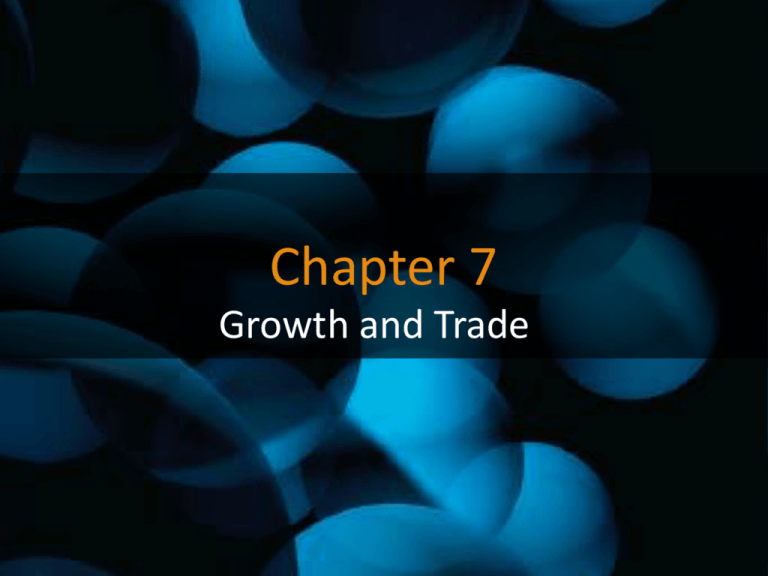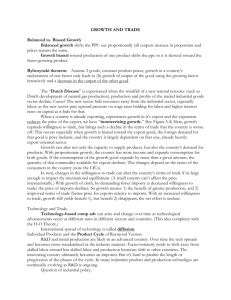
Chapter 7
Growth and Trade
Balanced Versus Biased Growth
• Growth in a country’s production capabilities shifts
the country’s production-possibility curve outward.
• As the ppc shifts out, we are interested in knowing
the effects on:
– The general shape of the production-possibility
curve
– The specific production quantities for the different
products, if product prices remain the same
© 2016 McGraw-Hill Education. All Rights Reserved.
2
Balanced and Biased Growth
© 2016 McGraw-Hill Education. All Rights Reserved.
3
Balanced and Biased Growth
• In balanced growth, the country’s production
possibilities curve (PPC) shifts out
proportionately so the its relative shape is the
same
• In biased growth, the expansion favors
proportionately more of one of the products,
so that the PPC will skewed toward the fastergrowing product.
© 2016 McGraw-Hill Education. All Rights Reserved.
4
Growth in Only One Factor
• Rybczynski Theorem: In a two-good world,
and assuming that product prices are
constant, growth in the country’s endowment
of one factor of production, with the other
factor unchanged, has two results:
– An increase in the output of the good that uses
the growing factor intensively
– A decrease in the output of the other good
© 2016 McGraw-Hill Education. All Rights Reserved.
5
Single-Factor Growth: The Rybczynski
Theorem
© 2016 McGraw-Hill Education. All Rights Reserved.
6
Changes in the Country’s Willingness
to Trade
• Production and consumption change with
growth, a country’s willingness to or interest
in engaging in international trade can change
– Increase willingness to trade (export and import
more)
– Decrease willingness to trade (export and import
less)
© 2016 McGraw-Hill Education. All Rights Reserved.
7
Effects on the Country’s Terms of Trade
• Small country case: If the country is small (i.e.
a price-taker in world trade), then its trade has
no impact on the international price ratio ( the
country’s terms of trade, TOT)
• Large country case: If a country is large, a
change in willingness to trade affects the
equilibrium international price ratio. This
change could either improve the country’s
TOT, or deteriorate the TOT.
© 2016 McGraw-Hill Education. All Rights Reserved.
8
Growth Biased Toward Replacing
Imports in a Large Country
• A reduction of a large country’s demand for
imports reduces the relative price of import
good—this change is an improvement in the
country’s terms of trade
• The country gains from growth for two
reasons:
– Production benefit from growth shifts the ppc out
– Better price for its exports relative to the price
paid for imports
© 2016 McGraw-Hill Education. All Rights Reserved.
9
Growth Biased Toward Replacing
Imports in a Large Country
© 2016 McGraw-Hill Education. All Rights Reserved.
10
Growth That Increases a Large
Country’s Willingness to Trade
• The increase in the country’s demand for
imports increases the relative price of the
import good (or the increase in the country’s
supply of exports reduces the relative price of
the export good).
• This change in the equilibrium international
price ratio is a deterioration in the country’s
terms of trade, the overall effect on the
country’s well-being is not clear.
© 2016 McGraw-Hill Education. All Rights Reserved.
11
Immiserizing Growth
Immiserizing growth: Growth that expands the
country’s willingness to trade can result in such
a large decline in the country’s terms of trade
that the country is worse off.
© 2016 McGraw-Hill Education. All Rights Reserved.
12
Immiserizing Growth
Three crucial conditions :
1. The country’s growth must be strongly biased toward
expanding the country’s supply of exports (increasing its
willingness to trade), and the increase in export supply
must be large enough to have a noticeable impact on
world prices.
2. The foreign demand for the country’s exports must be
price inelastic, so that an expansion in the country’s
export supply leads to a large drop in the international
price of the export product.
3. Before the growth, the country must be heavily
engaged in trade, so that the welfare loss from the
decline in terms of trade is great enough to offset the
gains from being able to produce more.
© 2016 McGraw-Hill Education. All Rights Reserved.
13
Immiserizing Growth in a Large Country
© 2016 McGraw-Hill Education. All Rights Reserved.
14
Technology and Trade
• Another basis for comparative advantage can
arise over time as technological changes occur
at different rates in different sectors and
countries.
• In some ways technology-based explanation is
an alternative that competes with the H-O
model.
• In other ways technology differences can be
consistent with an H-O view of the world.
© 2016 McGraw-Hill Education. All Rights Reserved.
15
Individual Products and the Product Cycle
According to the product cycle hypothesis, first
advanced by Raymond Vernon:
• When a product is first invented, the major demand
is mostly in high-income countries, and the product
still must be perfected by using additional R&D and
local production.
• Over time, the product and its production
technology become more standardized and familiar.
Factor intensity in production tends to shift away
from skilled labor toward less skilled labor.
• The technology diffuses and production locations
shift into other countries, eventually into developing
countries with abundant less-skilled workers.
© 2016 McGraw-Hill Education. All Rights Reserved.
16
Openness to Trade Affects Growth
• Openness to international trade can enhance
the technology that a country can use by
facilitating the diffusion of foreign-based
technology into the country and by
accelerating the domestic development of the
technology
– The growth rate for the country (and world as a
whole) increases in the long run
© 2016 McGraw-Hill Education. All Rights Reserved.
17







